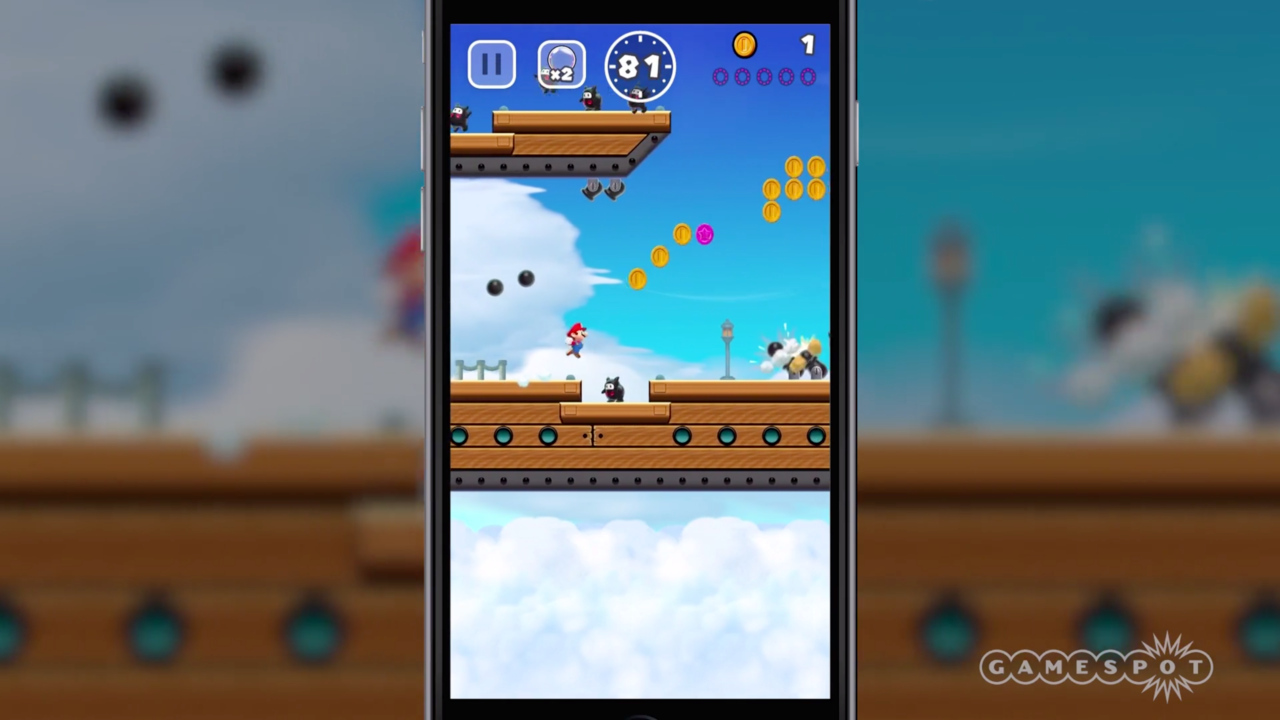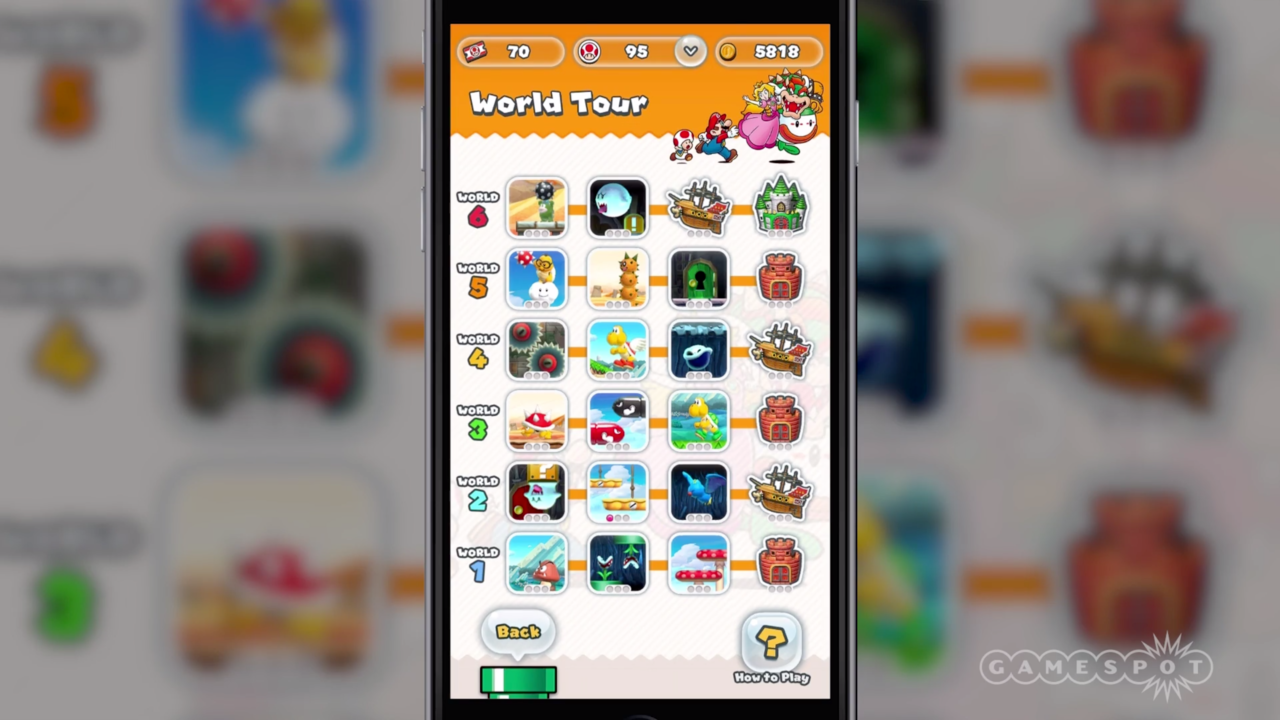The first few levels of Super Mario Run will make any Mario fan feel right at home, with the series' polished aesthetic, and Mario's characteristic agility, present and accounted for. Gaming's foremost plumber has even picked up a few new tricks that, ironically, make him seem more acrobatic despite Super Mario Run's simpler-than-usual controls. The game immediately feels like a winner, and you might find that it continues to be; it all depends on your willingness to revisit the same levels over and over again in search of modest rewards.
To be fair, Run is the most convenient Mario game there is, with 2D level design that lives up to the series' rock-solid reputation. It's also complemented with graphics and moves that compare favorably to the refined New Super Mario Bros. games on DS and 3DS. With portability, however, comes a few understandable sacrifices: you don't have full control of the new, ever-running Mario, and levels are short to better suit typical smartphone play sensibilities. Regardless of these changes, Run feels like a Mario game from beginning to the end of its adventure, and the ease with which you can make Mario jump, bounce off walls, and spin attack enemies in mid-air with a simple tap of the screen feels great, not limiting.
Rather than fight to reach the end of a level by mastering platforming, which is the easiest it's ever been, your ultimate goal is to collect coins on your way to the finish line. Familiar gold coins are aplenty, and are banked at the end of a level to construct your personal Mushroom Kingdom later on. But there are other, harder to reach coins in every level--five a piece--that require more finesse and strategic platforming than usual to acquire. Once you've grabbed every special coin in a given level, a new set of five is distributed that are harder to grab--with three sets of five per level.

As fun as Run's levels can be, they are undoubtedly short and easy, and it's not hard to finish all of them in less than two hours if you simply aim for the finish line. Beyond enjoying a taste of Mario's familiar and satisfying platforming, the aforementioned special coins are the sole reason to replay levels, both from a completionist standpoint, and because acquiring each and every coin of a given color in all levels unlocks a pipe that takes you to a special stage.
Without experiencing these levels firsthand, it's hard to know if the payoff is worth the effort. But when you choose to hunt for specific coins rather than simply enjoy the flow and excitement of platforming, Run loses some of its magic that made it so gratifying at the start. Replaying levels then becomes somewhat of a grind. With the small selection of levels and their brief nature, you're never so far removed from a stage that your next visit feels like a trip down memory lane either; repeatedly replaying Run's 1-minute-or-less stages quickly grows tiresome. And given that Mario is constantly moving forward, you are mostly at the mercy of his will rather than your own, which stands at odds with the series' tradition. It may not bother people who haven't played Mario in a while, but anyone who's kept up with the plumber over the years will recognize that something's missing: agency over one of the most enjoyable platforming characters around.
When you tire of chasing coins and replaying levels, you aren't left empty handed; you still have the Kingdom Builder and Toad Rally modes to explore. With a bank full of coins, you can construct a small kingdom with houses, flowers, and other flourishes. Outfitting your slice of land is both for personal gratification and for the populace of Toads that eventually move in. Rather than attract new neighbors through fancy landscaping, you need to impress them during Toad Rally challenges by collecting as many coins as possible in the allotted time--it's a coin trial rather than a time trial. You compete against the ghost of other players, and if you are the victor, you're awarded with a handful of Toads. They come in a small variety of colors, and it's important to diversify your town as it's the only way to unlock more expensive and rare items for your kingdom.
For the inherent sense of competition and the potential rewards tied to a successful Toad Rally run, these challenges become the most enjoyable excuse to continue playing Run. And if you manage to fill your Kingdom with Toads of all colors, you will eventually unlock new playable characters usable in both the main game and in Toad Rally races. Princess Peach becomes available after completing the game normally, and she comes with the usual ability to slowly float to the ground after jumping. Luigi, Yoshi, and Toadette must be earned through Toad Rally races, however. But after giving Peach a fair shake, the differences between her and Mario aren't meaningful enough to reinvigorate old stages. The competitive angle of Toad Rally could do wonders for the main levels, and there's a hint of it in the form of leaderboards--but you aren't comparing yourself to top-performing strangers, only to people you've manually added as friends.
At the end of the day, Super Mario Run is about working to build a beautiful and busy kingdom. While it may sound similar to a game like Neko Atsume where you attract cats by placing their favorite things in a space, Run doesn't let you see a town full of Toads; you see only a few, with the rest living as statistics in a menu.
The elephant in the room is the fact that smartphones are home to numerous persistent and endless running games, many of which are excellent, and free or far cheaper than the $10 you have to pay to play Run beyond the third level--or five minutes of gameplay. Run is definitely one of the most polished examples of a mobile running game, but without an option to run endlessly through a procedurally generated level, you never get a chance to savor the act of platforming--the game's best aspect--for long.

There's also the fact that Run's smartphone-game tendencies bleed over a bit too much and remind you that, while this is indeed a Mario game, it's a mobile game first and foremost. Beyond its "free-to-start" nature, there are timed bonus stages that beg you to jump back in every eight hours, but the rewards--small levels of chance where you may or may not earn the tickets required to participate in Toad Rally races--are hardly compelling reasons to watch the clock and jump back in as soon as possible. Strange as it may sound, if $10 won't unlock every character in the game, it would be nice to have an option to pay a small fee to Nintendo to simply unlock extra characters, rather than be forced to jump through hoops in different modes to access them in a roundabout way.
That's to say nothing of the game's always-online requirement. On one hand, it's a relief that should your phone lose a data connection in the middle of a level, you can still make it to the finish line, but Run simply will not start, or allow you to continue, if you are in a dead zone or without WiFi. For a game without traditional microtransactions or open-ended online competition, this requirement is simply baffling.
It's easy to fault Run for various reasons, but it's hard to totally lose appreciation for how well it's brought the series' core gameplay to smartphones. Simple controls be damned, Run offers great platforming and that distinct Mario charm that Nintendo's perfected over the years. It's a shame to find that it's on the easy side and bereft of a long-lasting platforming adventure, but it's the sort of game that you'll be happy to have in your pocket. Even if you don't play it to unlock every character and special course, finishing the game once will inspire you to dust off New Super Mario Bros. and revisit Run's quality roots on other platforms--a testament to the series' refined DNA than lives on in Run.









